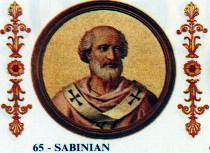Pope Sabinian
|
Pope Sabinian |
|
|---|---|
 |
|
| Papacy began | 13 September 604 |
| Papacy ended | 22 February 606 |
| Predecessor | Gregory I |
| Successor | Boniface III |
| Personal details | |
| Born | Blera, Eastern Roman Empire |
| Died | 22 February 606 Rome, Eastern Roman Empire |
Pope Sabinian (Latin: Sabinianus, died 22 February 606) was Pope from 13 September 604 to his death in 606. Pope during the Byzantine (Eastern Roman) domination of the Papacy, he was fourth former apocrisiarius to Constantinople elected pope.
Sabinian was born at Blera (Bieda) near Viterbo. He had been sent by Pope Gregory I as Apostolic nuncio, to Constantinople, but he apparently was not entirely satisfactory in that office. He returned to Rome in 597.
He was probably consecrated pope on 13 September 604. He incurred unpopularity by his unseasonable economies, although the Liber Pontificalis states that he distributed grain during a famine at Rome under his pontificate. The erudite Italian Augustinian Onofrio Panvinio (1529–1568), in his Epitome pontificum Romanorum (Venice, 1557), attributes to him the introduction of the custom of ringing bells at the canonical hours and the celebration of the Eucharist. The first attribution of this was in Guillaume Durand's thirteenth-century Rationale Divinorum Officiorum.
During his reign, Sabinian was seen as a counterfoil to his predecessor Pope Gregory I. Whereas Gregory distributed grain to the Roman populace as invasion loomed, Sabinian sold it for high prices (though this may be a later interpolation by Gregory's biographers). The Liber Pontificalis praises him for "filling the church with clergy," in contrast to Gregory, who rose rapidly from simple monk to bishop of Rome.
...
Wikipedia
